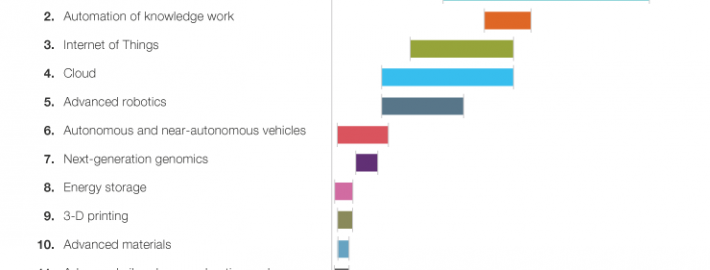Disruptive Innovations, That Will Change Our Lives.
[vc_row][vc_column width=”1/1″][vc_column_text]
McKinsey Global Institute publishes study on innovations that will transform life, business, and the global economy
We are in an ever changing parade of new innovations on numerous fronts. Just about every development in technology is charged as a leap forward, and we are constantly looking for the “next big thing”. However, not every upcoming innovation will truly be able to influence the business or social landscape, but some of them might be disruptive for existing conditions and change the way we live and work. As such it is important as a business leader to comprehend which technologies will matter to them and how to prepare for changes.[/vc_column_text][vc_separator][/vc_column][/vc_row][vc_row][vc_column width=”1/1″][vc_column_text]
Disruptive technologies: Advances that will transform life, business, and the global economy. (McKinsey Global Institute)
[/vc_column_text][/vc_column][/vc_row][vc_row][vc_column width=”1/1″][vc_column_text]
A report from the McKinsey Global Institute, cuts through the noise and identifies 12 technologies that could drive truly massive economic transformations and disruptions in the coming years. The report also looks at exactly how these technologies could change our world, as well as their benefits and challenges, and offers guidelines to help leaders from businesses and other institutions respond.
[/vc_column_text][/vc_column][/vc_row][vc_row][vc_column width=”1/1″][vc_column_text]
A short introduction to the study and the described disruptive innovations
McKinsey concludes that the potential investment affect of the 12 technologies evaluated in the report could be between $14 trillion and $33 trillion a year in 2025. Their assessment is focused around an in-depth dissection of key potential provisions and the value they could create in various ways, including the consumer benefit that emerges from better products and services, lower costs, a a safer and cleaner environment, and in general a better wellbeing.
A few innovations itemized in the report have been around for a long time and in this sense will be familiar. Others are all the more astounding.[/vc_column_text][/vc_column][/vc_row][vc_row][vc_column width=”1/1″][vc_column_text]
Some examples:
[/vc_column_text][vc_accordion][vc_accordion_tab title=”Advanced robotics”][vc_column_text]
Advanced robotics—that is, increasingly capable robots or robotic tools, with enhanced “senses,” dexterity, and intelligence—can take on tasks once thought too delicate or uneconomical to automate. These technologies can also generate significant societal benefits, including robotic surgical systems that make procedures less invasive, as well as robotic prosthetics and “exoskeletons” that restore functions of amputees and the elderly.
[/vc_column_text][/vc_accordion_tab][vc_accordion_tab title=”Next-generation genomics”][vc_column_text]
Next-generation genomics marries the science used for imaging nucleotide base pairs (the units that make up DNA) with rapidly advancing computational and analytic capabilities. As our understanding of the genomic makeup of humans increases, so does the ability to manipulate genes and improve health diagnostics and treatments. Next-generation genomics will offer similar advances in our understanding of plants and animals, potentially creating opportunities to improve the performance of agriculture and to create high-value substances—for instance, ethanol and biodiesel—from ordinary organisms, such as E. coli bacteria.
[/vc_column_text][/vc_accordion_tab][vc_accordion_tab title=”Energy-storage devices”][vc_column_text]
Energy-storage devices or physical systems store energy for later use. These technologies, such as lithium-ion batteries and fuel cells, already power electric and hybrid vehicles, along with billions of portable consumer electronics. Over the coming decade, advancing energy-storage technology could make electric vehicles cost competitive, bring electricity to remote areas of developing countries, and improve the efficiency of the utility grid.
[/vc_column_text][/vc_accordion_tab][/vc_accordion][/vc_column][/vc_row][vc_row][vc_column width=”1/1″][vc_column_text]
Take-Aways and Outlook
The potential gain of the technologies talked about in the report, are enormous. Equally tremendous are the challenges attached to them and the impact they might have. Businesses and governments need to prepare for the impact of these innovations today, not waiting until these technologies are pushing their full influence on the economy. While the reactions will differ by stakeholder and technology, we find that certain guiding standards can help organizations and governments as they anticipate the impacts of disruptive technologies.[/vc_column_text][/vc_column][/vc_row][vc_row][vc_column width=”1/2″][vc_column_text]Where do you stand, when it comes to disruptive innovations? Let us know what you think![/vc_column_text][/vc_column][vc_column width=”1/2″][vc_column_text]Parts of this article have originally been posted on McKinsey Insights & Publications in May 2013.
Executive Summary (3 MB); Full Report (4MB)[/vc_column_text][/vc_column][/vc_row][vc_row][vc_column width=”1/1″][vc_separator][/vc_column][/vc_row][vc_row][vc_column][vc_column_text]
[/vc_column_text][/vc_column][/vc_row][vc_row][vc_column][vc_column_text]
Related articles
[/vc_column_text][/vc_column][/vc_row]









Leave a Reply
Want to join the discussion?Feel free to contribute!